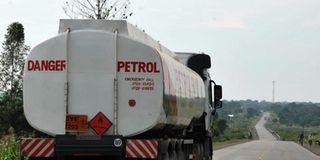New system to ease fuel importation

A fuel truck heads towards Kampala from Kenya on the Bugiri-Iganga highway. With the single customs territory system, clearance of trucks from Mombasa to Malaba will be speedy. FILE PHOTO
What you need to know:
Relief. This will significantly reduce congestion and delays at the border points.
Kampala.
All fuel imported into Uganda through Kenya will be cleared using the single customs territory (SCT) system with effect from February 3, a Uganda Revenue Authority (URA) official has said.
This move signals the beginning of the long-awaited enforcement of the single customs territory (SCT) system, an East African Community initiative to speed up the clearance of goods at the regional key point of entry—Mombasa port.
“All fuel imported into Uganda through Kenya will be cleared using the Single Customs Territory (SCT) system with effect from 3rd February,” the commissioner customs URA, Mr Richard Kamajugo, was quoted as saying in a statement issued by the tax body.
For URA, implementation of the single customs territory means it will collect revenues from cargo destined to Uganda before even the goods reach the country.
This is because all goods imported through Mombasa will be cleared at the port and taxes paid in the respective regional countries.
“Under SCT clearance procedures, Customs declarations are made electronically and the declarations processed and released by URA prior to loading fuel at the different loading depots in Kenya,” Mr Kamajugo said.
Before, clearance of trucks from Mombasa to Malaba or Busia would take nearly 20-days and in some cases even more.
But with the enforcement of the SCT the number of days spent in clearing is expected to drop to four days.
This will also see trucks move in less than a day from Kisumu and Eldoret to Malaba/Busia unlike the three days journey before.
Also, weighbridges that previously existed have since been reduced with only one remaining in Kenya.
The removal of weighbridges ensures a seamless flow of goods along the trade route thereby reducing on time cargo takes to reach its destination.
After the successful implementations of the Fuel Clearance process, next will be enforcement of dry cargo/containers under the same initiative—SCT.




